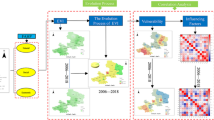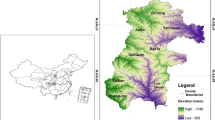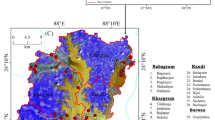Abstract
The farming–pastoral zone in China is located in the monsoonal region. It has large fluctuations in precipitation and land use. It is one of the most obvious areas of ecological vulnerability. Taking Yulin City of Shanxi Province as an example, this paper builds an indicator system and then uses principal component analysis (PCA) and analytic hierarchy process (AHP) to filter indicators and determine weights. Finally, this paper establishes an ecological vulnerability index (EVI) model. Through the classification of EVI, the spatial distribution map of ecological vulnerability in Yulin City is obtained. The results show that the ecological vulnerability in Yulin City tends to decrease from north to south. Among counties, Fugu, Shenmu, Yuyang and Dingbian are extremely fragile, and the main causes of ecological vulnerability are economics, landscape diversity, annual precipitation and vegetation coverage.
Access provided by Autonomous University of Puebla. Download conference paper PDF
Similar content being viewed by others
Keywords
1 Introduction
When ecosystem is intervened by outside, it will make sensitive reactions and self-recovery reactions, and this is ecological vulnerability [1]. China’s farming–pastoral zone is located in the monsoon climate zone of Southeast Asia, and with large precipitation fluctuations, has characteristic of fragile ecology. Yulin City is an area where ecology is particularly fragile. The ecological environment research of Yulin and the whole farming–pastoral zone has attracted extensive attention from scholars. However, the main method for ecological assessment of Yulin is single-factor evaluation method [2,3,4,5,6]. And a few methods for ecological vulnerability evaluation still have problems of large correlation between indicators and strong subjectivity of weight determination [7,8,9]. These years, remote sensing is used in ecological research, and it makes data acquisition simpler and data types more abundant [10,11,12]. This paper uses remote sensing, meteorological and statistical yearbook data, principal component analysis (PCA) and analytic hierarchy process (AHP) to obtain ecological vulnerability index and analyzes the overall status, spatial distribution and causes of ecological vulnerability of Yulin.
2 Study Area
Yulin is located in the northernmost part of Shanxi Province, between N 36°57′ –N 39°35′ and E 107°28′–E 111°15′. It has typical semiarid and arid climate, and the average annual precipitation is close to 400 mm. There are three landforms: windblown grass beach, loess hilly and gully, and beam-shaped low hills. The mineral resource is diverse and rich in total. It is an important energy export city in China. Special climate, topography, soil texture and high-intensity human activities make it a typical ecologically fragile area in the northern farming–pastoral zone.
3 Methods and Data
3.1 Construction of Ecological Vulnerability Indicator System
This paper constructs an evaluation indicator system from three aspects: ecological sensitivity, ecological restoration and ecological stress [13, 14]. Taking into account the availability of data, 13 indicators were chosen to constitute the indicator system. The indicator system is shown in Fig. 1.
3.2 Evaluation Indicator Selection and Weight Determination
3.2.1 Standardization of Primary Selection Indicators
We standardize the primary selection indicators to make them be unified to 0–1, so that the values are closer to 1 indicating that the ecology is more fragile [4]. Eight indicators of temperature, elevation, slope, aspect, soil erodibility factor, soil erosion intensity, GDP density and population density are positively correlated with ecological vulnerability; landscape diversity index, vegetation coverage, precipitation, relative humidity and GPP are negatively correlated with ecological vulnerability. The standardized formulas are shown in Eqs. 1 and 2, respectively.
\(P^{*i}\) represents the value after the normalization of the ith evaluation indicator, \(P^{i}\) represents the value before the ith evaluation indicator is normalized, \(P_{{\text{max}}}\) represents the maximum value of the ith evaluation indicator, and \(P_{{\text{min}}}\) represents the minimum value of the ith evaluation indicator [4].
3.2.2 Selection of Evaluation Indicators
We use the PCA to analyze 13 standardized primary evaluation indicators [15,16,17,18,19]. Table 1 shows the results of sorting the principal components according to the contribution value. The cumulative contribution rate of the first five is 86.81%, which is more than 85%, indicating that the first five principal components can cover most information of the primary selection indicators, so the first five principal components are selected as evaluation indicators. Table 2 shows eigenvectors corresponding to each principal component.
3.2.3 Determination of Indicator Weights
We use AHP to determine indicator weights. The assignment principle of the pairwise comparison matrix is shown in Table 3. The larger the value, the greater the influence of the ith element on the previous indicator layer compared to the jth element.
This paper constructs a pairwise comparison matrix based on the contribution rates of the first five principal components. Equation 3 is proposed to calculate relative importance scale, \(A_{ij}\) represents the relative importance scale of elements i and j, and \(\alpha_{i}\) and \(\alpha_{j}\) represent the contribution rates of elements i and j. A is the pairwise comparison matrix constructed. After calculation, the weights of the evaluation indicators are: 0.5350, 0.2868, 0.0853, 0.0555, 0.0374.
3.3 Evaluation Model
The five evaluation indicators are graded by the natural discontinuity grading method shown in Table 4. The higher the level, the higher the ecological vulnerability.
In Eq. 4, EVI represents the ecological vulnerability index; \(w_{i}\) represents the weight of the ith evaluation indicator; \(f_{i}\) represents the level of the ith evaluation indicator [4].
3.4 Data Sources and Preprocessing
The soil erosion intensity is calculated according to RUSLE model (modified general soil loss model) based on the above data [20,21,22]. Thirteen indicators are unified into 1 km resolution, UTM_Zone_49N (Table 5).
4 Results and Analysis
4.1 Overall State of Ecological Vulnerability
The EVI is classified as shown in Table 6. Yulin has the largest area with severe vulnerability, accounting for 25.7% of the city’s area. Moderate and above vulnerability account for nearly 70% of the city’s area, and only 20% of the city’s area is micro-vulnerability.
4.2 Spatial Distribution of Ecological Vulnerability
The distribution of ecological vulnerability levels is shown in Fig. 2. The proportion of vulnerability levels in various districts and counties is shown in Fig. 3. The ecological vulnerability level of Yulin is characterized by high north and low south. Fugu, Shenmu, Yuyang and Dingbian are most fragile. These four counties have 20–45% extremely vulnerable areas. Especially in Shenmu, extremely vulnerable areas account for 45% of the county’s area.
4.3 Analysis of the Causes of Ecological Vulnerability
Figure 4 depicts the standardized evaluation indicators of various districts and counties in Yulin. The closer the evaluation indicator is to 1, the greater the vulnerability of the county. The main causes of ecological vulnerability in Dingbian are single landscape, low vegetation coverage and low precipitation. The reason for the ecological vulnerability of Fugu and Shenmu is human production activities and single landscape types. These two counties develop coal industry vigorously, and this leads to a decline in landscape diversity and increase in ecological vulnerability. The main reason for the ecological vulnerability of Yuyang is the landscape type is not rich enough and coupled with the pressure of human activities on the environment, and vegetation coverage is low. The main reason for the ecological fragility in Jingbian is that the landscape type is not rich and the precipitation is small. The 5/6 population in Jingbian is agricultural population, and less precipitation in arid areas will restrict the growth of crops and reduce the stability of the agricultural and livestock ecosystem. Vegetation coverage and aspect are the main reasons for the ecological fragility of Hengshan. There is a large area of half-sunny slope in Hengshan, and water evaporation on sunny slope is fast, which is not conducive to vegetation growth. One of the most obvious features of the six southern counties is the large K value and high vegetation coverage, and the vegetation has a tightening effect on the soil thus decreasing EVI.
5 Summary
This paper processes remote sensing, and meteorological and socioeconomic data, and uses PCA and AHP to calculate EVI. The main research results were as follows:
-
1.
The method of combining PCA and AHP is used to construct the EVI model, which reduces the correlation between indicators and improves the objectivity of weight determination.
-
2.
Obtain the distribution map of vulnerability level. It is found that the ecological of six northern counties is more fragile than six southern counties. The extremely fragile areas are Fugu, Shenmu, Yuyang and Dingbian.
-
3.
The main causes for the ecological vulnerability of the farming–pastoral zone in Yulin were economics, landscape diversity, annual precipitation and vegetation coverage.
References
Zhengjia L, Xingxiu Y, Lei L, Mei H (2011) Vulnerability assessment of eco-environment in Yimeng mountainous area of Shandong Province based on SRP conceptual mode. Chin J Appl Ecol 8:2084–2090
Qiufang S, Peihao P, Jie H, Liu Z, Xiaofei S, Huaiyong S (2016) Monitoring eco-environmental vulnerability in Anning River Basin in the upper reaches of the Yangtze River using remote sensing techniques. Remote Sens Land Resour 28(2):175–181
Furong (2008) Remote sensing monitoring of ecological environment in the typical region of fragile ecological restoration in the farming-pastoral ecotone—Taking Zhenglan banner as an example. Inner Mongolia Normal University
Pan L, Deyong H, Wenji Z (2010) The monitoring of changes of land vegetation covers by remote sensing in farming-pastoral mixed zones of North Chiana—A case study in Guyuan County, Hebei Provinc. Remote Sens Land Resour 2:113–117
Jiangbo G, Wenjuan H, Dongsheng Z, Shaohong. W (2016) Comprehensive assessment of natural ecosystem vulnerability in Tibetan Plateau based on satellite-derived datasets. Sci Geogr Sin 4:580–587
Jingli L (2009) Quantitative evaluation of Gansu Wen County soil erosion based on RUSLE model. Lanzhou University
Jing Z (2016) Based on RS and GIS the Erguna Wetlands ecological vulnerability assessment. Southwest Jiaotong University
Wei D, Xingzhong Y, Rong S, Yuewei Z (2016) Eco-vulnerability Assessment based on remote sensing in the argo-pastoral ecotone of North China. Environ Sci Technol 39(11):174–181
Shao H, Liu M, Shao Q, Sun X, Wu J (2014) Research on eco-environmental vulnerability evaluation of the Anning River Basin in the Upper Reaches of the Yangtze River. Environ Earth Sci 72(5):1555–1568
Shuang X, Runping S, Xiaoyue Y (2012) A comparative study of different vegetation indices for estimating vegetation coverage based on the dimidiate pixel model. Remote Sens Land Resour 4:95–100
Scanlon TM, Albertson JD, Caylor KK, Williams CA (2002) Determining land surface fractional cover from NDVI and rainfall time series for a savanna ecosystem. Remote Sens Environ 82(2):376–388
Carlson TN, Ripley DA (1997) On the relation between NDVI, fractional vegetation cover, and leaf area index. Remote Sens Environ 62(3):241–252
Tingting X (2016) Assessment of soil erosion in karst area Based on RUSLE model—A case study in the Southwest of Songzi. Huazhong University of Science and Technology
Yonghua L, Qiang F, Xue W et al (2015) Spatial and temporal differentiation of ecological vulnerability under the frequency of natural hazard based on SRP model: A case study in Chaoyang county. Sci Geogr Sin 35(11):1452–1459
Jian S, Jun C (2012) Principal component analysis and its application (A). Light Ind Technol. 9:12–13
Vaughan RA (1990) A review of: “Introduction to Remote Sensing”. In: Campbell JB (ed) The Guilford Press, Guilford, 1987. p 551. Price£ 34.95. Remote Sen 11(10):1932
Jensen JR Lulla K (2007) Introductory digital image processing: a remote sensing perspective. Science Press
Lillesand T, Kiefer RW, Chipman J (2000) Remote sensing and image interpretation, 6th edn. Remote sensing and image interpretation. Wiley, pp 3035
Elkington MD (1987) A review of: “Remote Sensing Digital Image Analysis: An Introduction”. In: Richards JA (ed) Springer, Berlin, Heidelberg. New York, 1986, p 281. Price DM (1987) 138. Int J Remote Sen 8(7):1075–1075
Bin W, Jinbai H, Xinglong G (2015) Grid soil moisture constants estimation based on HWSD over basin. Hydrology 35(2):8–11
Bin W, Xingchen D, Jinbai H et al (2017) Grid runoff parameters estimation and adjustment of GSAC model based on HWSD. Trans Chin Soc Agric Mach 48(9):250–256
Nachtergaele FO, Velthuizen H, Verelst L et al (2012) Harmonized world soil database (version 1.2)
Acknowledgements
Fund projects National Key Research and Development Program of China (2017YFC0405806).
Author information
Authors and Affiliations
Corresponding author
Editor information
Editors and Affiliations
Rights and permissions
Copyright information
© 2020 Springer Nature Singapore Pte Ltd.
About this paper
Cite this paper
Zhong, Y., Cheng, J., Meng, L., Zhang, W. (2020). Ecological Vulnerability Assessment and Cause Analysis of the Farming–Pastoral Zone in Northern China—Taking Yulin City as an Example. In: Wang, L., Wu, Y., Gong, J. (eds) Proceedings of the 6th China High Resolution Earth Observation Conference (CHREOC 2019). CHREOC 2019. Lecture Notes in Electrical Engineering, vol 657. Springer, Singapore. https://doi.org/10.1007/978-981-15-3947-3_11
Download citation
DOI: https://doi.org/10.1007/978-981-15-3947-3_11
Published:
Publisher Name: Springer, Singapore
Print ISBN: 978-981-15-3946-6
Online ISBN: 978-981-15-3947-3
eBook Packages: EngineeringEngineering (R0)








